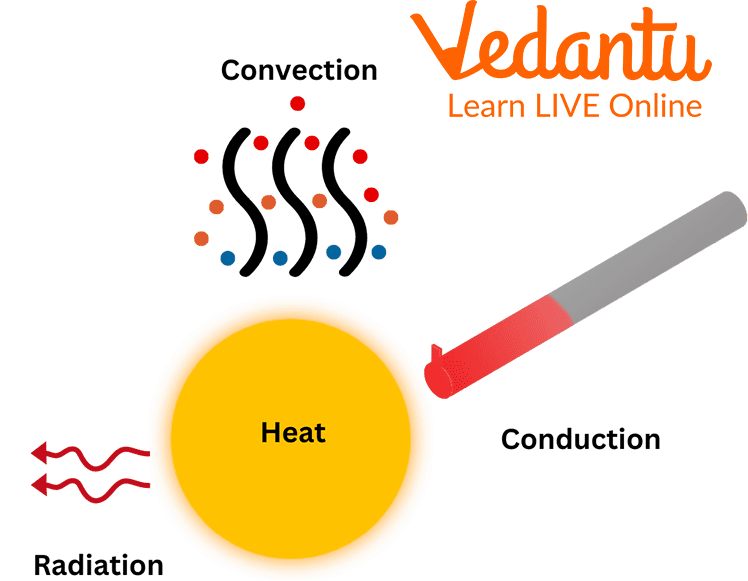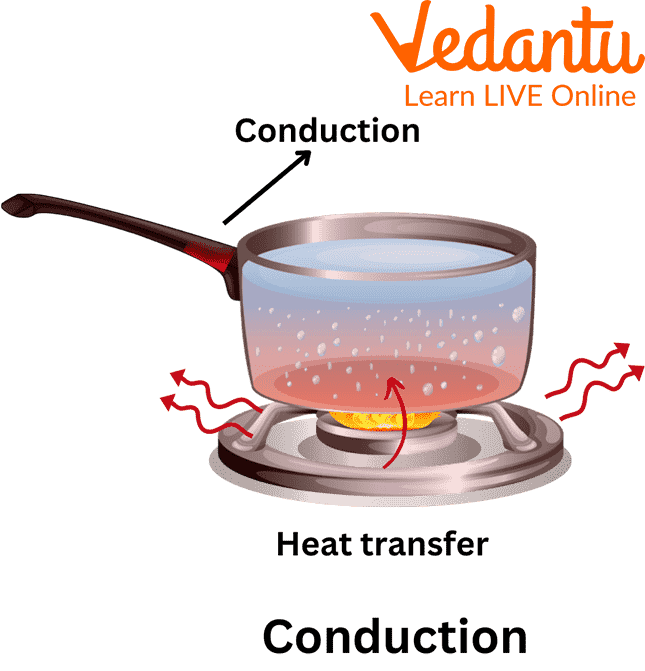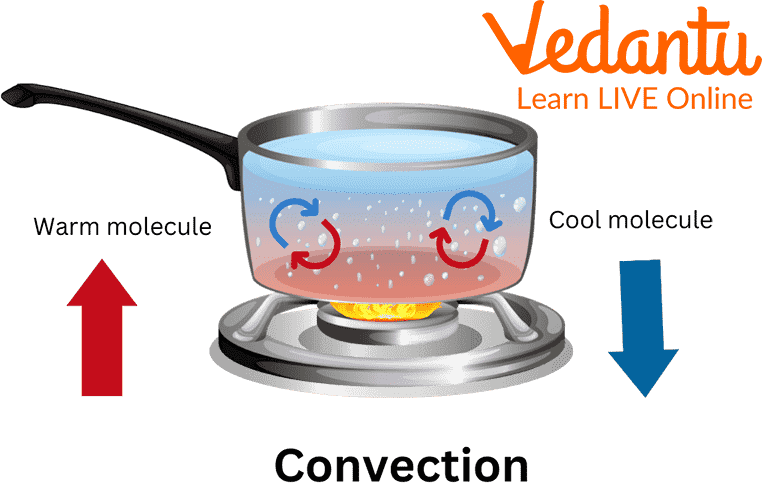




Overview about Heat Transfer
Kids, have you ever touched a hot object? Have you wondered how things heat up? Come, let us learn about heat transfer today. The transfer of heat energy or thermal energy from one object to another is called heat transfer. Heat is transferred from the objects at certain temperatures, from high to cold. An interesting fact about heat is that it does not depend on any material medium to transfer. In this article, we will read about the different methods of heat transfer in detail. At the end, we will finally be able to answer the different questions about heat transfer. Let’s dive right in and learn more about heat transfer.

Heat Transfer
Methods of Heat Transfer:
Heat transfers through our surroundings all of the time. Children, have you ever been to a beach on a sunny day? There you must have noticed walking on the sand feels hot, and diving into the ocean feels cold. Eating ice cream on the way back from school on a sunny day goes from chilled to cool to warm and then melts all over your ice cream stick, flowing on your hand at a rapid rate. Heat transfers happen to us every time throughout the day.
There are primarily three methods of heat transfer in nature.
Conduction heat transfer
Convection heat transfer
Radiation heat transfer

Methods of Heat Transfer
Conduction Heat Transfer
Conduction is the transfer of heat between the objects directly contacting each other. The better the conductor, the more rapidly heat energy will transfer. There are a variety of good conductors. A few of them are copper, iron, silver, steel, etc. Also, there are some terrible conductors, also known as insulators. The insulator includes wood, paper, air, etc. That is why it is not recommended to pick up a pile of iron rods sitting in the sun unless you want to burn your hand, but there is no restriction in picking up a bundle of paper kept in the sun.

Conduction Heat Transfer
Convection Heat Transfer:
The up and down movement of gases and liquids caused by thermal or heat energy transfer is called convection. As a gas or liquid is heated, it warms, expands and rises because it is less dense. When the gas or liquid cools, it becomes thicker and falls. Warming and rising and cooling and falling create a convection current. This is the primary way heat moves through gases and liquids. Some examples include the warmer water on a pool surface and floating in a hot air balloon. Heat flow in convection occurs in a relative path from hot fluid to cold fluid regions. This heat flow is caused by molecular motion.

Radiation Heat Transfer:
Let's now talk about radiation. Radiation is defined as the electromagnetic waves travelling through space. When these electromagnetic waves come in contact with an object, the waves transfer the heat energy to that object. It is heat travelling in the form of visible or non-visible light. Have you ever noticed standing near a campfire on a cold night feels very good and warm? The heat travelling through that campfire to warm up your body is through radiation. Some other examples of radiation are reheating cold food in a microwave and turning on the lights of the room.

Radiation Heat Transfer
Facts About Heat Transfer:
Let us know some amazing facts about heat transfer:
Understanding how heat transfers make it easier to find efficient ways to warm and cool our houses, keep people safe from overheating and create new and innovative technologies to improve our living.
Good conductors of heat are great conductors of electricity too. Hence, copper is also used to make wires for our houses and stores in which the electric current flows, thus generating electricity.
The faster the molecules of an object move, they generate heat, which increases that object's overall temperature.
The transfer of heat happens until the objects between whom the heat transfer is happening come into an equilibrium state.
In some cases, heating an object can expand the area of that object, while cooling an object can shrink the object.
Summary
In the above article, we read about heat transfer and methods of heat transfer. Conduction, convection and radiation are three critical ways through which heat transfer in our environment. They are the heat transfer principles we experience every day. Heat is an energy which moves from hotter objects to cooler objects. The coldness or hotness of any object is measured by the rise and loss in its temperature. Objects are constituted of minute particles, and the movement of these particles generates heat and makes the object hot. Transfer of heat may or may not be dependent on the medium. Conduction and convection require a medium for heat to flow, while the transfer of heat from radiation is a medium-less process. We hope you enjoyed reading this article, in case of any other doubts feel free to ask in the comments.
FAQs on All About of Heat Transfer
1. What is heat transfer and what is its fundamental principle?
Heat transfer is the movement of thermal energy from one object or area to another. The fundamental principle is that heat always flows naturally from a region of higher temperature to a region of lower temperature. This process continues until both regions reach the same temperature, a state known as thermal equilibrium.
2. What are the three main types of heat transfer? Explain with examples.
The three main modes of heat transfer are Conduction, Convection, and Radiation. They are essential for understanding how heat moves in our environment.
- Conduction: This is the transfer of heat through direct contact. Heat moves from one particle to another without the particles changing their position. Example: A metal spoon getting hot when placed in a cup of hot tea.
- Convection: This occurs when heat is transferred through the movement of fluids (liquids or gases). Hotter, less dense fluid rises, and cooler, denser fluid sinks, creating a convection current. Example: Boiling water in a pot.
- Radiation: This is the transfer of heat through electromagnetic waves, which can travel through a vacuum. It does not require any medium. Example: The warmth you feel from the sun or a campfire.
3. How do land and sea breezes demonstrate the principle of convection?
Land and sea breezes are perfect real-world examples of convection currents. During the day, the land heats up faster than the sea. The air above the land becomes hot and rises. To fill this space, cooler, denser air from over the sea moves towards the land, creating a sea breeze. At night, the process reverses. The land cools down faster than the sea, so the air above the sea is now warmer, rises, and cooler air from the land moves towards the sea, creating a land breeze.
4. What is the difference between conductors and insulators of heat?
The primary difference lies in how well they allow heat to pass through them. Conductors are materials that permit heat to travel through them easily. Metals like copper, aluminium, and iron are excellent conductors. This is why cooking pans are made of metal. In contrast, insulators are materials that resist or block the flow of heat. Examples include wood, plastic, glass, and air. They are used in handles of cooking utensils and in thermos flasks to prevent heat transfer.
5. Why is it advised to wear light-coloured clothes in summer and dark-coloured clothes in winter?
This advice is based on how different colours interact with heat radiation. Light-coloured surfaces are poor absorbers and good reflectors of heat. By wearing light colours in summer, we reflect most of the sun's heat and stay cooler. Conversely, dark-coloured surfaces are good absorbers of heat. Wearing dark clothes in winter helps absorb more heat from the sun, keeping our bodies warmer.
6. How does heat from the Sun reach Earth through the vacuum of space?
Heat from the Sun reaches us primarily through radiation. Unlike conduction and convection, which require a medium (solid, liquid, or gas) to transfer heat, radiation uses electromagnetic waves. These waves can travel through the vacuum of space. When this radiation reaches Earth, it is absorbed by the atmosphere, land, and water, which then heats our planet.
7. Can heat be transferred from a colder body to a hotter body?
Yes, but not spontaneously. While heat naturally flows from hot to cold, it can be forced to move from a colder region to a hotter one by using external energy. This process is called forced heat transfer and is the working principle behind devices like refrigerators and air conditioners. They use a compressor and refrigerant to actively pump heat out of a cold space (like the inside of a fridge) into a warmer environment (the kitchen).
8. What are some everyday applications of heat transfer principles?
Heat transfer principles are applied in many everyday technologies and phenomena. Some common applications include:
- Cooking: Using conduction to cook food on a pan, convection in an oven, and radiation in a microwave.
- Thermos Flask: Using a vacuum and silvered surfaces to minimise heat transfer by all three modes, keeping liquids hot or cold.
- Room Heaters: Using convection to circulate warm air around a room and radiation to warm nearby objects.
- Vehicle Radiators: Using convection to transfer excess heat from the engine to the air.
- Greenhouses: Trapping solar radiation to keep plants warm in a colder climate.









